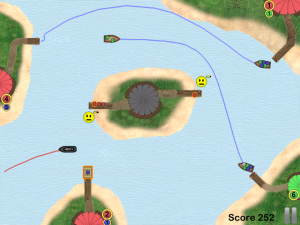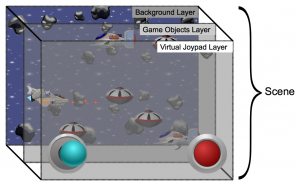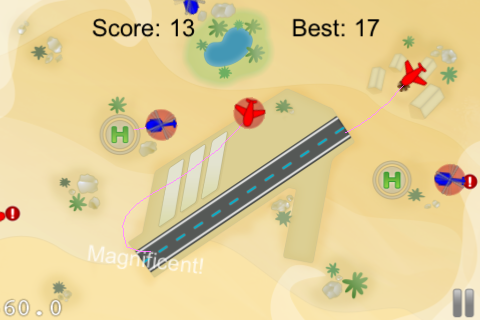My Line-Drawing Game Starterkit is now up to date with the latest versions of cocos2d (v1.0.1), iOS (compatible with iOS 3.1 and higher, including iOS 5.0), Xcode (compatible with Xcode 3.2 and above, including Xcode 4.0 on Snow Leopard and Xcode 4.2 on Mac OS X Lion).
Existing customers will receive an email with instructions on how to download the updated version of the Line-Drawing Game Starterkit.
Ferries HD was made with the Line-Drawing Starterkit
I’ve added another cool game made to the Line-Drawing Starterkit product page - Ferries HD by Thomas Busse:
Note: the game is not included in the Starterkit. It’s a game that was made with the Starterkit and serves as a great example of what you can achieve with the Line-Drawing Game Starterkit.
Price dropped to $99 (from $119)
I dropped the price of the Line-Drawing Game Starterkit to $99 in anticipation of upcoming commercial source code products that I’m working on. More on that in due time, first things first (Learn Cocos2D 2nd Edition and Kobold2D).
What about Kobold2D?
I know, I know. Kobold2D isn’t too far out. I anticipate the first preview (beta) release in August. Stay alert.
What’s left to do at a minimum is to write the Project Starter tool (to give you the convenience of Xcode 4 Project Templates but with more flexibility), setup the website with the “getting started” documentation plus API references and perform some general project cleanup.
And when is the Learn Cocos2D 2nd Edition coming out?
It looks like the new edition of the book will be out in October, roughly two months later than anticipated.
On the positive side I’m working with a new editor who brought in a fresh perspective from which the book greatly benefits. The delay also allowed me to make more substantial improvements than initially planned.
In particular Chapter 3 (Essentials) was completely overhauled to better explain the fundamental concepts of Cocos2D, and you’ll find the book to be more visually rich in general. For example this exploded view drawing is used to explain the relationship of Scenes, Layers and Nodes:
The book’s source code already uses the recently released Cocos2D v1.0.1 and I will continue to update the book’s source code for the v1.x line of Cocos2D. Several of the game projects discussed in the book will also be ported to become Kobold2D project templates.
Today it was exactly 6 months since I made the first sale of my Line-Drawing Game Starterkit for Cocos2D. I just glanced at the number labelled “Total” in the Plimus control panel: $18,479.05 … all of this from a single product over a period of 6 months!
No Product Launch Formula
I wish I could tell you exactly how to reproduce that level of success. I certainly did not implement the widely publicized and so called product launch formula. I’m sure PLF is valuable but the way it’s being sold makes it a scam to my mind. Why? Because it’s sold only once or twice a year, you can never just buy it, you have to wait for it, and when it goes on sale, people are more than happy to pay an outrageous price for something they could get much cheaper from reading the proper books and applying some common sense. That’s just a side note.
I also have to admit, I have no hard data where my customers are coming from other than they’re from all over the world. Or why each of them is buying or why some of them are interested but end up not doing it. Some will have followed me for quite a while, some found my website via google, others got wind of it through word of mouth and most recently they may have read about the Starterkit in my Learn Cocos2D book.
For the most part I have only informal data that I can share.
Little hard data
Thankful customers writing me that this was exactly what they’ve been looking for, and why. Only 3 refunds if I recall correctly, two were expecting something different and another one found Corona shortly after buying and decided to use Corona over Cocos2D, so he wasn’t going to use my Starterkit. As far as I can tell, most customers are not companies or teams of people but individual developers.
The level of support requests I received were minimal. I estimate that less than 10% of all customers contacted me for support, and almost all support incidents were solved after exchanging one or two emails. Most issues were caused by the fact that I didn’t include Cocos2D with the download, so they were mostly Cocos2D version mismatches and incorrect project setups. I definitely learned from that and will be including Cocos2D in all future versions of the Starterkit to cut down support incidents even more.
Clearly, there are two distinct groups of customers: those who would like to learn how to write a Line-Drawing game, hoping to eventually release it and in any case learn to understand Cocos2D and game development a little better on the side. And then those who plan to publish a commercial Line-Drawing game and want to cut corners, speed up development.
What I learned
For a while I was thinking that you need to have a frequently visited website like mine - over 5,000 visits per week here. You need to be well connected (followed) on Twitter. A Newsletter with many people on it that you can write to at any time is also very helpful. And having been a long time developer at Electronic Arts must surely be reassuring that I know what I’m doing. Next to actually showing that by writing a book. None of that is something you can do in just a couple of days or weeks.
I’m happy to report that you don’t need any of that to reproduce the success I’ve had with my Starterkit.
So skip your job application for EA, scrap the book draft and save your money on yet another type of scam: how to get 10,000 Twitter followers in 30 days. You don’t need them. Dan Nelson told me recently that the source code for his BATAK Duel game sold 14 copies in less than a month, priced at $297 (now: $149.99). The product page was just a simple blog post and yet still managed to bring in over $4,000 of revenue in the first month! For comparison, the first 30 days of the Line-Drawing Kit amounted to sales worth $5,370 revenue (before tax and everything).
BATAK Duel gameplay video:
I can also say with certainty that promo codes are a great idea, my 50% sale was a huge success. It generated over $4,000 in revenue and with another $5,000 made in the first month that means that half of my sales were generated by only two events: product launch, and 50% off promo codes. Maybe there’s something to the product launch formulas after all? But honestly, I think that’s just common sense. If you want to sell something, don’t sit around hoping for customers coming to you. Just as much as sex sells (in general), events sell products. Price drops, bundles, freebies, and so on. Get the word out, and do it frequently, and give something away for free - the simplest being information, knowledge, share experiences and data.
And think Steam!
I could have done more of that. But I was writing a book and it was also kind of an experiment to see how sales are affected if I’m not promoting the product in any way for a while. It was sobering to see sales drop to just a few per month three months after launch. Likewise it was exciting to see the reception (and sales) during the 50% sales event.
What I can also say with confidence is that if you offer a products that developers are interested in, they will buy it. And quite a number of developers are interested in commercial source code products to make this a viable market. It’s not just game code, it’s also components for regular App development that are very popular and lucrative.
The Secret is: Common Sense
And there’s another secret I’d like to share: developing an App Store game takes months to complete it, and if you’re truly passionate it can take even more months just to polish it, get it right in every aspect. Still your chances of tanking in the market are rather high, the stakes are high but the risks are even higher, even more so the longer you’ve spent developing your game.
So it’s only going to be a matter of time before more developers learn the secret that selling one’s source code for a game that’s already on the App Store is not just an additional revenue stream, it’s a rather lucrative one and one that allows you to cross-promote both products. In fact, suddenly you have two products on two different markets for two different kinds of customers with very little extra effort.
Don’t put all your eggs in one basket. Think about it. It makes perfect sense.
Even more so for me because I have always enjoyed working on game technology and enabling game developers to excel more than actually finishing a game, with polished gameplay, an intuitive user experience and fixing all those obscure bugs cropping up at the last minute.
Also, if you need help making sales, I have good news for you: there will be an affiliate store available here in the next couple weeks. If you’re interested in becoming an affiliate, give me a shout.
I’m pleased to announce that the Line-Drawing Game Starterkit is finally available for sale! It’s a source code project for anyone interested in developing a line-drawing game. The gameplay is modelled after the famous Flight Control game. The Starterkit works with the latest cocos2d v0.99.4 version and will at the very least receive compatibility upgrades for future cocos2d versions.
Hop on over to the product page to check out the feature list, the API documentation and a source code sample. You can also download the Starterkit App for iPhone from iTunes. The iPad Edition is still in approval.
Note: for the reminder of July 2010 you can get the Starterkit at an introductory price for only $179!
Positioning of the Starterkit
I’m sorry that you’ve had to wait one and a half months compared to the initially planned release date of June 1st. I double and triple checked every decision I made and you can see some of the results on the Starterkit product page.
I’ve also decided to increase the regular price from the initially intended $199 to $299 effective from August 1st, 2010. One of the reasons being that I initially planned to have multiple licenses including Indie and Commercial ones. I thought long and hard about positioning the Starterkit and eventually decided to sell only Site Licenses. For the individual developer it costs a bit more but for small and commercial teams it’s great news, and small teams and established, dedicated developers is who I am targeting. Those who really appreciate the value of commercial source code saving days and weeks of research and development, and all the trouble, sweat and pain associated with it. And I’m here to help if you have any questions regarding the Starterkit’s source code.
I don’t have plans to make another Starterkit and in all likelihood it will remain the only commercial cocos2d-related product for the remainder of this year.
Book Chapter about Line-Drawing Games
For those who are disappointed about the new price, either grab the Starterkit before August 1st or wait until December for the Learn iPhone and iPad Cocos2D Game Development book I’m writing. It will contain a chapter covering some of the basic aspects of a line-drawing game but without the finer details and complex interactions conveyed in the Starterkit. It’ll be Chapter 12 so in about 8 weeks (Mid-September) I’ll mention it in my weekly book chapter posts.
Closed Sales Period, Summary of
And here’s for transparency: exactly 10 days ago I informed the 668 subscribers of my Newsletter of the closed sales period. The password-protected Starterkit product page received just over 200 unique visitors. During the last 10 days I made 9 sales amounting to about $1,530 with Plimus’ 5% fee already deducted but obviously before tax. All sales were made within the first 4 days after I sent the Newsletter and for the last 6 days sales were absolutely zero. Although I’ve been in contact with several interested parties who didn’t want to or simply couldn’t buy it right now for various reasons. If you’re one of them: you’ll get it for $179 no matter when you make the purchase, just contact me beforehand.
Right now I’m curious to see how sales will be now that the Starterkit is publicly available.
Starterkit Promotion
I’d appreciate if you would tweet and re-tweet this post and mention the Starterkit to all fellow cocos2d-sians! If you would even go so far as writing a serious and honest review on your blog, please get in touch with me.
Just don’t test the waters by mentioning the Starterkit in the cocos2d community forum.
Stance Lance
I wish Ricardo had taken the time to be considerate and then talked to me instead of running off making an assumptive, excessive, and for the most part irrelevant (off-topic) stance post which only served to cause a big commotion among his community while allowing his forum rule “Treat people with respect.” to become a farce.
In Conclusion
In hindsight I’m glad that the whole thing got me thinking in so many new directions. Most importantly it got me in contact with a lot of developers who consciously don’t post on the cocos2d forum. To get those encouraging words and positive feedback and gaining interesting insights from other developer’s perspectives - especially those who tag along silently - really helped me understand the cocos2d development community better. Thank you, you know who you are!
The whole shebang also served as a great motivational factor to pour my everything into the cocos2d book, which came at just the right time to let off steam in just the right way. I’m writing it to be the cocos2d documentation it deserves and the one I always wished it had. I can’t even begin to describe how satisfying it feels to write this book. So much in fact that it hurts to stop writing every time I reach the 27 pages each chapter is expected to have. 















